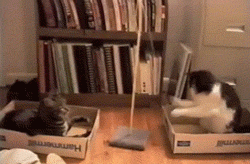
The Benefits of Play for Senior Cats
Share
As cats enter their golden years, their play habits often change—but the need for mental and physical stimulation remains just as vital as it was during their kittenhood. The slowing pace of an older cat’s life can deceive owners into thinking their feline friend no longer desires or requires playtime, but nothing could be further from the truth. Play serves as more than mere entertainment for senior cats; it’s a lifeline to cognitive sharpness, muscle maintenance, emotional wellbeing, and even pain management. The right kind of play, adapted to an aging cat’s changing abilities, can stave off the lethargy and decline often mistaken as inevitable aspects of growing old.

Do Senior Cats Still Need Playtime? (And Why It Matters More Than You Think)
The physical benefits of play for senior cats begin with something as simple as maintaining mobility. Arthritis affects approximately 90% of cats over age twelve, causing stiffness that leads to reduced activity—which in turn worsens joint health through disuse. Gentle, low-impact play encourages movement without strain, helping to preserve range of motion in aging joints. The act of stretching forward during a slow chase game or carefully pivoting to track a feather wand provides natural physical therapy, lubricating stiff joints through controlled motion. Even the subtle muscle contractions involved in batting at a toy help combat the sarcopenia (age-related muscle loss) that weakens older cats, preserving the strength needed for basic functions like jumping onto favorite perches or properly grooming hard-to-reach areas.
Cognitive preservation forms another critical benefit often overlooked in senior feline care. Feline cognitive dysfunction syndrome (FCDS), the cat equivalent of dementia, affects over 50% of cats aged fifteen and older. Play acts as a protective factor against this decline by providing mental stimulation that strengthens neural pathways. Puzzle toys that require problem-solving to access treats, interactive games that trigger hunting instincts, and even simple object-permanence exercises (hiding toys under blankets) all serve to keep an aging cat’s mind engaged. The neurological benefits extend beyond preventing dementia—regular play has been shown to reduce stress hormones like cortisol while increasing serotonin production, creating a natural mood boost for cats prone to geriatric anxiety or depression.
The emotional and behavioral impacts of play prove just as significant as the physical advantages. Senior cats often face profound changes in their household dynamics—new pets, children, or even alterations in owner schedules due to retirement. Play provides a comforting constant amid these shifts, reinforcing the bond between cat and human through positive shared experiences. For cats mourning the loss of a companion animal, interactive play sessions can help alleviate grief by triggering endorphin release. Even basic play helps regulate sleep-wake cycles in older cats prone to nighttime restlessness or excessive daytime sleeping, providing structure that brings comfort to aging felines who thrive on routine.

Butterfly & Bird Training Cat Toy

Pain management through play might seem counterintuitive, but carefully modulated activity serves as nature’s anti-inflammatory. The gentle movement encouraged by play increases circulation, bringing oxygen and nutrients to arthritic joints while flushing out inflammatory byproducts. The mental distraction of play also helps cats temporarily transcend chronic discomfort—much like humans forgetting a headache when engrossed in a good book. Owners should learn to recognize their cat’s unique “play threshold”—the point where enjoyment turns to fatigue—and always conclude sessions while the cat is still engaged, creating positive associations that will have them seeking out more activity.
Adapting play to an older cat’s changing abilities requires thoughtful modifications. The frenetic leaps of youth give way to more strategic, ground-based play as joints stiffen. Wand toys should be moved slowly with longer pauses between movements, allowing extra reaction time. Puzzle feeders with larger pieces prevent frustration from declining eyesight or less precise paw control. Warm-up becomes crucial—a few minutes of gentle petting or massage before play helps loosen stiff muscles. Play surfaces should provide secure footing—placing rugs or yoga mats over slippery floors prevents painful missteps that could deter future activity. Most importantly, play sessions must be shorter but more frequent—five minutes several times daily proves far more beneficial than one long session that leaves the cat sore and reluctant to engage again.

The social component of play changes as cats age. Where kittens play primarily to develop skills, senior cats play primarily to connect. The presence of a trusted human during play provides emotional security that encourages risk-taking within safe boundaries—an arthritic cat might attempt a slightly higher jump or longer stretch when feeling supported. This social bonding through play becomes particularly vital for single-cat households where opportunities for interaction decrease as owners assume their aging pet “just wants to sleep.” Even observational play—watching birds at a feeder or fish in a tank—should be a shared experience, with the owner providing narration and encouragement to keep the cat mentally engaged.
Nutritional play combines mealtime with mental stimulation for senior cats who may be losing interest in food. Hiding small portions of kibble around play areas encourages natural foraging behaviors, while puzzle feeders slow eating to prevent regurgitation—a common issue in older cats. The act of “working” for food satisfies instinctual needs that simple bowl feeding cannot, often sparking increased appetite in cats who’ve become indifferent eaters. This approach proves especially valuable for managing weight in less mobile seniors—the calories burned during gentle food-seeking play help maintain healthy body condition without demanding intense physical exertion.
Recognizing when play becomes counterproductive requires attunement to subtle signals. Heavy panting, sudden irritability, or excessive lag time between movements all indicate it’s time to stop. Post-play recovery matters too—providing a warm, soft resting area immediately after activity helps prevent stiffness. Some cats benefit from gentle “cool down” massages focusing on their shoulders and hips. Owners should track their cat’s play responses in a journal, noting which activities elicit the most engagement and which seem to cause discomfort, creating a personalized play profile that evolves with the cat’s changing needs.


The ripple effects of sustained play in senior cats extend into overall health management. Active cats tend to have better-regulated digestive systems, reducing constipation risks. The mental engagement from play may help delay medication resistance in cats requiring regular treatments by keeping their brains flexible and adaptable. Even hydration improves—cats who play tend to drink more water, a critical factor in preventing urinary and kidney issues prevalent in older felines. Veterinary visits often go more smoothly for cats accustomed to handling through play, making essential health monitoring less stressful for all involved.
Ultimately, play in senior cats isn’t about recapturing kittenhood but about honoring each life stage’s unique needs and capacities. The slower, more thoughtful play of an older cat carries its own beauty—the careful calculation before a pounce, the dignified batting at a ball rather than frenzied chasing, the deep purrs of satisfaction rather than the wild energy bursts of youth. By adapting our expectations and methods, we give our aging companions the profound gift of continued engagement with the world—proof that while their steps may have slowed, their capacity for joy remains boundless.
